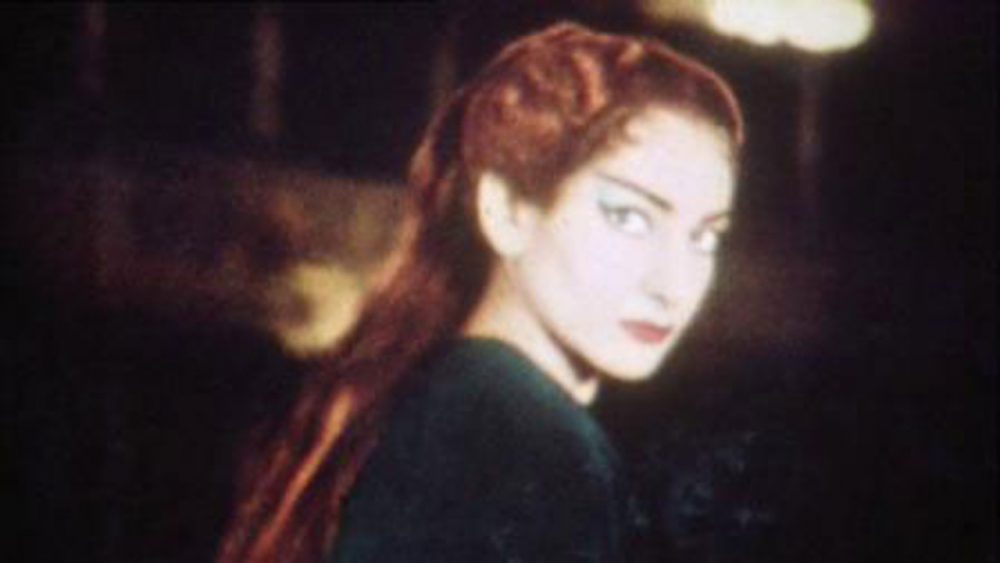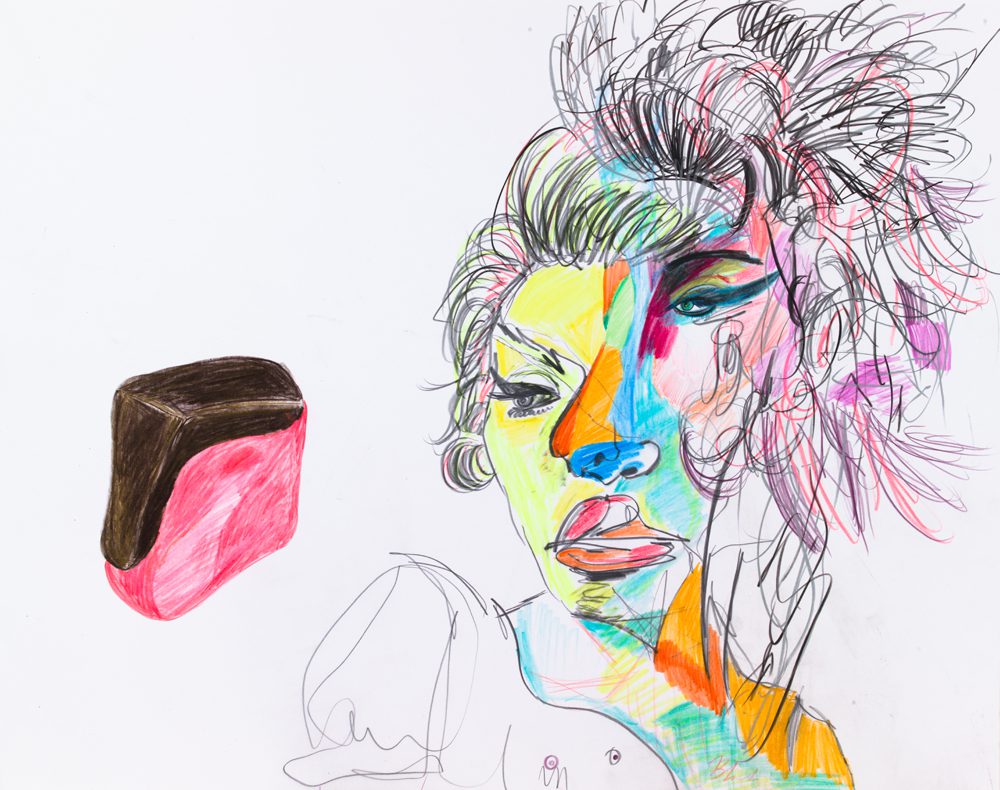Two Divas: Picturing Maria Callas and Amy Winehouse
Dana Kopel looks at portraits by two artists—Werner Schroeter and Rachel Harrison—and contemplates parallels between their tragic subjects.

A still from director Werner Schroeter’s Maria Callas Porträt (1968).
MARIA
A glamorous woman with pale skin and thick wings of black eyeliner stares at the camera in three-quarter profile. The lights go dark around her until only her face is illuminated. The camera pans until we realize it’s not the woman but a photograph of her—flat, static.
Werner Schroeter’s Maria Callas Porträt (1968) portrays the renowned opera singer largely through still photographs—the camera moves around them, fawning over her image. It lingers on Callas wearing jewel-toned gowns or an elaborate pearl headdress, her gaze always piercing. Schroeter’s nearly 13-minute film cuts, slowly and then quickly, between repeating images of the diva in various performances: She stands at an elaborate dinner table; she brandishes a knife. Recordings of her singing play over the rush of images, each frozen like the look of a fetishist fixed on his object of desire. Maria Callas Porträt is not simply a portrait, as its title implies, but an act of total adoration.
Like much of Schroeter’s later work, Maria Callas Porträt evinces an interest in camp, performance, excess, and experimentation—and in Callas herself, who was also the subject of several of his other early 8mm films. Schroeter was a cult underground filmmaker associated with the New German Cinema of the 1960s; he was a contemporary of Rainer Werner Fassbinder—who cited Schroeter as an influence and whose films Schroeter sometimes appeared in. Schroeter’s cinematic attention to glamorous, tragic women, not unlike Fassbinder’s (in The Bitter Tears of Petra von Kant [1972], for instance) was as much an evocation of a high camp sensibility as a political gesture: In positing a queer (dis)identification between female diva and gay male auteur, Schroeter locates gender in a fragmented performativity, just as his montage-based technique challenges the conventions of filmmaking.
The photographs of Callas that constitute Schroeter’s film don’t resolve into a cohesive whole. Instead, they suggest a multiplicity of selves—or images of the self, rather—kaleidoscopically refracting the woman-as-icon into a collection of visual fragments. Maria Callas Porträt feels, at points, like an endless stream of images generated through a Google search, though it was made decades before the existence of the search engine. In this way, the film speaks presciently to the proliferation of images that characterizes contemporary life—especially for someone whose life is lived in the public eye.
But the film is arguably not about life. In its last few minutes, the camera focuses on newspaper clippings, bits of text in German from a review of one of Callas’ performances, each word or phrase framed by darkness. The text rapturously describes her “puppet”-like movements, her “lithe body foreshadowing human suffering,” the “knowing sadness…[and] cadences of insanity” that she conveys with her voice. At the very end of Schroeter’s film, his camera holds the word ist, part of the text’s final sentence, in a small circle, and then returns to another word in that sentence, Todesschrei—meaning “death cry.” By ending on Callas’ soprano death cry, or rather a description of it, Maria Callas Porträt becomes a memorial to the diva, although she died years after Schroeter’s film was made. Death was an integral part of many of Callas’ operatic performances—she was known for her roles as the titular characters in Madama Butterfly, La Gioconda, and Tosca, all of whom commit suicide—and by extension, Schroeter suggests, of her persona and image. The inaudible death cry that closes the film—premature by nearly a decade—intensifies the disappearance of her likeness, suggesting that Callas herself may never have been present, or knowable, at all.

Rachel Harrison, Untitled, 2012. Colored pencil on paper. Courtesy the artist and Greene Naftali, New York.
AMY
If images are the most obvious way that female celebrity is both constituted and consumed, they also contain an element of death itself, a tragic sense of impermanence: Such glamour, beauty, and artistry can’t survive in this cruel world. And if the diva is, by the nature of opera, a figure deeply bound up in tragedy, then perhaps Schroeter’s portrait of Callas can instruct us on how the narrative of tragedy manifests in today’s celebrity culture, with its relentless combination of adoration and scrutiny, visibility and distance.
In 2012, Rachel Harrison debuted a series of drawings of Amy Winehouse in her exhibition “The Help” at Greene Naftali in New York. The untitled colored-pencil drawings echo the brightly hued sculptural assemblages for which Harrison is well known (and which were also on display at the gallery); they build upon her longstanding interest in pop-cultural and historical figures, depicting Winehouse, who died of alcohol poisoning in July 2011, in a variety of abstracted bust portraits. In the drawings, the British singer’s mouth is often open and she sometimes grips a microphone. Her artistic medium, her voice, cannot be captured in a drawing, of course—and Harrison doesn’t attempt to depict it. Instead, she’s drawn to the visual cues with which we identify Amy Winehouse as more than just a singer, as a star.
Harrison implies Winehouse’s cultural significance by situating her, in the drawings, within a collection of art-historically important subjects. Most are double portraits, of Winehouse and other figures, which often reference the history of Modernist figurative painting. Pablo Picasso is cited frequently; Harrison’s recreation of his portrait of Gertrude Stein appears alongside a blue sketch of Winehouse singing into a microphone, her heavily lined eyes askew in a parody of the artist’s signature style. Another features Winehouse drawn in a variety of colorful patches, again recalling Cubism, and posed alongside Marcel Duchamp’s sculpture Coin de chasteté [Wedge of Chastity], 1954–1963—marking female sexuality as a concern of Modernist art while retrospectively claiming female agency over its representation.
In another drawing, Winehouse emerges from a greenish cube and belts into a microphone, flanked by a blue-toned sketch of the artist Martin Kippenberger in his underwear. Though the drawings are much stranger and more layered than a straightforward feminist art-historical project, Harrison marks, for the record, Winehouse as a legendary performer and a glamorous and gifted woman—and one who wore thick, winged black eyeliner as part of her signature look. It’s eerie the way Winehouse’s eye makeup, by coincidence, replicates Callas’. And Harrison’s drawings, like Schroeter’s film, navigate a careful balance between identification and mythology. Each is a form of devotion and an exploration of the muse as a tragic figure. Harrison in particular situates her drawings of Winehouse within a larger exploration of artistic production; as the exhibition’s press release notes, her work in “The Help” “explores the passion and pathology of the tortured artist, a figure suspended between the pressures of ambitious creative vision and the public hunger for performance.”
It’s a paradigm of artistic creation that’s been largely exhausted by the legacy of poststructuralism within contemporary art—if a Romantic sensibility persists in recent practices, it’s generally without a self-mythologizing biographical impulse—but one that remains present, and endlessly fascinating, within popular culture. If the tortured artist has historically been male, both Harrison and Schroeter look beyond their own media and genres—and specifically to song—to emphasize the cultural resonance, the queer vulnerability, and the tragedy of female artistic voice. More than this, they offer portraits of women whose foremost roles were as cultural obsessions, women whose fame derived from their vocal talents but whose lives—and deaths—were thoroughly mediated by the visual.



